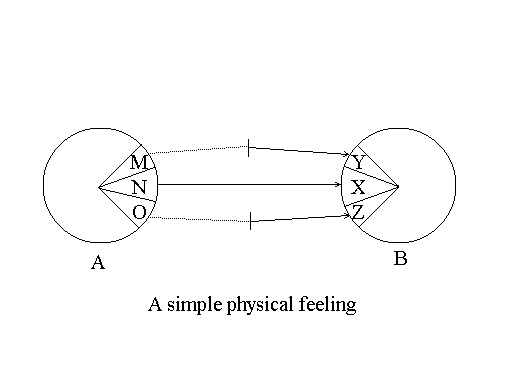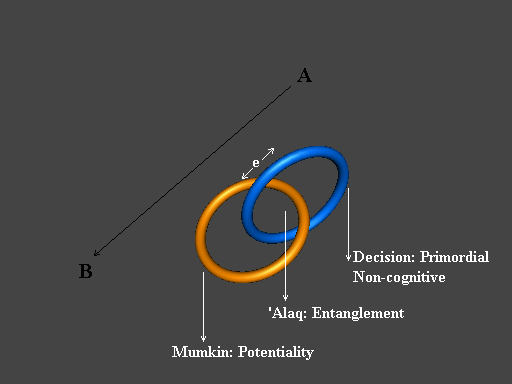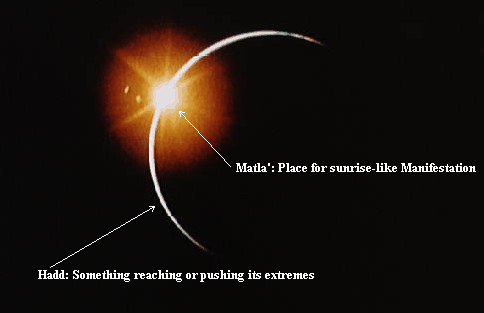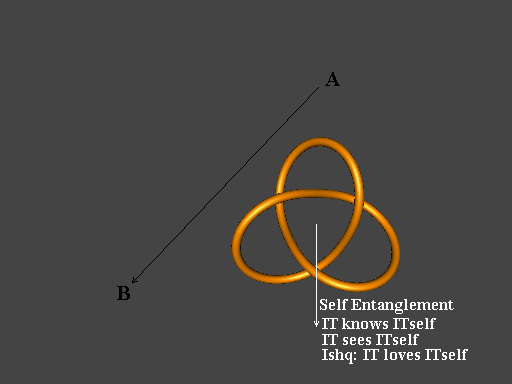Prehension (Idrāk)
Discussion Join
Horizon/Sunrize
Self-Entanglement or Ishq
Sea Also:
http://www.untiredwithloving.org/idrak.html
The earlier write-up
Note: The normal text is that of
Alfred North Whitehead’s Process and
Reality, the italicized text is that of Donald Sherburne’s A key to
Whitehead’s Process and Reality.
Prehension
The first analysis of an actual entity, into its most concrete
elements, discloses it to be a concrescence of prehensions, which have
originated in its process of becoming. All further analysis is an
analysis of prehensions. Every prehension consists of three factors: a)
the ‘subject’ which is prehending, namely, the actual entity in which
that prehension is a concrete element; b) the ‘datum’ which is
prehended; c) the ‘subjective form’ which is HOW that subject prehends
that datum.
Datum
A ‘simple physical feeling’ entertained in one subject is a feeling for
which the initial datum is another single actual entity, and the
objective datum is another feeling entertained by the later actual
entity.
Subjective Form (Feelings)
A feeling—i.e., a positive prehension—is a transition effecting a
concrescence. Its complex constitution is analyzable into five factors
which express what that transition consists of, and effects. The
factors are: (i) the ‘subject’ which feels, (ii) the ‘initial data’
which are to be felt, (iii) the ‘elimination’ in virtue of negative
prehensions, (iv) the ‘objective datum’ which is felt, (v) the
‘subjective form’ which is HOW that subject feels the objective datum.
An actual entity, on its subjective side, is nothing else that what the
universe is for it, including its own reactions. The reactions are the
subjective forms of the feelings. There are many species of subjective
forms, such as emotions, valuations, purposes, aversions, aversions,
consciousness, etc.
The essential novelty of a feeling attaches to its subjective form. The
initial data, and even the objective datum, may have served other
feelings with other subjects, the subjective form is the immediate
novelty; it is how that subject is feeling that objective datum. There
is no tearing this subjective form from the novelty of this
concrescence. It is enveloped in the immediacy of its immediate
present. The subjective form is the ingression of novel form peculiar
to the new particular fact, and with its peculiar model of fusion with
the objective datum. In the becoming, it meets the ‘data’ which are
selected from the actual world.
The way in which the feeling feels expresses how the feeling came into
being. It expresses the purpose which urged it forward, and the
obstacles which it encountered, and the indeterminations which were
dissolved by the originative decisions of the subject.
Physical feelings are always derived from some antecedent experient.
Occasion B prehends occasion A an antecedent subject experiencing a
sensum with [subjective form of] emotional intensity. B’s subjective
form of emotion is conformed to A’s subjective form. Thus there is a
vector transmission of emotional feeling of a sensum from A to B.
In
this way feels the sensum as derived from A and feels it with an
emotional form also derived from A. This is the most primitive form of
the feeling of casual efficacy. In physics it is the transmission
of a
form of energy.

Here a diagram will help with the
reader visualize the relationships
described. An actual entity has been seen to be constituted by its
feelings, or prehensions. Hence each actual entity will be portrayed as
a pie cut into pieces—the pie is the sum of its pieces as the actual
entity is the sum of its prehensions. In following figure, B is the
concrescing, subject actual entity, the entity in the process of
becoming. A is an actual entity in the immediate past of B, which is
being prehended by B. X is one of the B’s prehensions, the prehension
that “reaches out” to include A in B, the “vector’ (from the Latin,
vectus, past participle of veho, to carry—used in mathematics to denote
a line having a fixed direction in space) that bears the
A-ness of A
into B. M, N, and O are
prehensions constitutive of A. N is the
particular prehension in A selected by B to represent A, to objectify
A, B’s concrescence. All the other prehensions of A are negatively
prehended by B; Y and Z represent negative prehensions that eliminative
certain aspects of A’s constitution from relevance to B’s feeling.
Letters inserted in the following correlate Whiteheads descriptive
phrases with the labels of the following figure.
Thus in a simple physical feeling X there are two actual entities
concerned. One of them B is the subject of that feeling, and the other
A is the initial datum of the feeling. A second feeling N is also
concerned, namely, the objective datum of the simple physical feeling.
This second feeling N is the ‘objectification’ of its subject A for
the subject B of the simple physical feeling X. The initial datum A is
objectified as being the subject of the feeling N which is the
objective datum: the
objectification is the ‘perspective’ of the
initial datum. The prehension N in on subject A becomes the
objective
datum for the prehension X in a later subject B, thus objectifying the
earlier subject A for the later subject B.
In phraseology of
mathematical physics a feeling has a ‘vector’
character. A feeling X is the agency by which other things A are
built
into the constitution of its (X’s) one subject in process of
concrescence B.
A simple physical feeling is an act of causation. The actual entity
which is the initial datum A is the ‘cause’, the simple physical
feeling X is the ‘effect’, and the subject entertaining the simple
physical feeling B is the actual entity ‘conditioned’ by the effect.
Therefore simple physical feelings will also be called ‘causal’
feelings [or feelings of causal efficacy]. The ‘power’ of one actual
entity on the other is simply how the former is objectified in the
constitution of the other.
Negative Prehension
The short summary of this account of a living cell is as
follows: (i) An extremely complex and delicately posed chemical
structure, (ii) for the occasions in the interstitial ‘empty’ space a
complex objective datum derived from this complex structure; (iii)
under normal ‘responsive’ treatment, devoid of originality, the complex
detail reduced to physical simplicity by negative prehensions; (iv)
this detail preserved for positive feeling by the emotional and
purposive readjustments produced by originality of conceptual feeling
(Appetition); (v) the physical distortion of the field, leading to
instability of the structure; (vi) the structure accepting repair by
food from the environment.
Source: Process of Reality, The Order of Nature, Section X.
Decision
From a wondeful paper by Kevin Winters: (Click here to
download PDF)
The primary actualities that Whitehead terms “actual entities” are “the
final real
things of which the world is made. There is no going behind actual
entities to find
anything more real.” Another common term used for actual entities is
‘actual
occasions,’ which more fully expresses Whitehead’s view. Furthermore,
these actual
occasions are not anything in particular but a broad category that
applies to all actualities;
everything that we experience and understand, even ourselves, is an
actual occasion:
They differ among themselves: God is an actual entity, and so is the
most trivial
puff of existence in far-off empty space. But, though there are
gradations of
importance, and diversities of function, yet in the principles which
actuality
exemplifies all are on the same level.
The above is essential for the “ontological principle” that states,
“actual entities are the
only reasons; so that to search for a reason is to search for one or
more actual entities.”
In short, all things that exist, whether illusion or concrete, can be
explained by appealing
to an actual occasion or series of actual occasions; actual occasions
are sources of
meaning and hence the ‘reasons’ for why things are the way they are.
Actual occasions, by their nature, are not really ‘things’ in the
substance sense,
but are “drops of experience, complex and interdependent.”
The scientific basis of Whitehead’s view of actual occasions as “drops”
rather
than enduring substances is found in the then-recent discovery of the
quantum leap, in
tandem with the Planck length. In a quantum leap, an electron ‘jumps’
energy levels—its
place within the orbit of a nucleus—without traversing any of the space
in between.
Planck’s constant gives a similar notion: space is not continuous in
that particles cannot
move any distance; rather, they must move equal to or greater than the
Planck length—
10 EXP-33 centimeters. Once one rejects the immaterialist’s view and
accept some form of
materialism, one cannot speak of entities as enduring seamlessly
through space—they
‘occur’ in chunks that are incapable of sustaining continuous existence
in space.
Whitehead, as will be seen later, also quantizes time to the same
effect—entities do not
endure through time but occur in quantized bits and pieces.This
rejection of the
continuous nature of space-time is central to understanding Whitehead’s
view.
The occasion’s becoming an ‘object’ can be better understood by viewing
it in
terms of quantized space-time. Consider two actual occasions on a
subatomic level:
object a is currently ‘in’ the state in between Planck’s time while
object b is at the very
beginning of Planck’s time. At that instant, object a’s current state
cannot be included in
object b’s causal influence; only object a as it was found at the end
of its previous Planck
time can be included in b’s causal present. Thus, in terms of b’s
present, a is an ‘object’
only as it was found in its past, but not in terms of its current
state. This concept can be
further extended when viewed in terms of the theory of relativity and
causation.
Prior to the objectification of the physical pole is the
mental pole,12 characterized by “a principle of unrest,”
teeters on the “realization of what is not and may be.”13
When an actual occasion is in its mental mode of
existence—in the terms of physics, its state in between Planck’s
time—it has no definable
properties (as in the physical pole), but is in an indeterminate state
of potentiality and
‘indecision.’ The actual occasion prehends (see “Prehension and Phases
of
Concrescence” below) the possible expressions of its potentiality (i.e.
“what is not and
may be”)14 and is left to ‘decide’ which state it will actualize—it is
not fully determined
by its past.15 A macro-analogy is our own everyday thinking and
decision-making (a
higher-level expression of the mental pole): we have the options before
us, weigh and
consider them, possibly with some trepidation, and ultimately decide
which possibility to
actualize. This, Whitehead proposes, occurs in all actual occasions,
simple or complex,
though, in relation to the former, on a fundamentally more primitive
level.16 The
12 Whitehead distinguishes between ‘mind’ and ‘intellect’; only the
latter includes conscious thought. Mind
can generally be defined as the creation of novelty in an actual
occasion, whereas intellect is an example of
a higher manifestation of mind. While the former is found in all actual
occasions, the latter is only found in
complex occasions. See “Organizational Duality” below for further
distinctions and clarification.
13 Ibid, 32.
14 The ‘possibilities’ that are prehended are termed ‘eternal objects.’
Eternal objects find their existence in
God who is thereby the giver of the possibility of novelty. Whitehead
held that these ‘objects’ are
necessary aspects of God; he cannot arbitrarily decide to have them at
one time and discard them at another
time. Many will readily see the Platonic basis of this concept (which
Whitehead readily admits) and many
have attempted to create a process metaphysic without eternal objects,
including the current author. But,
given Whitehead’s views and the very foundations on which his
metaphysic rests (i.e. the ontological
principle), all attempts to restructure process thought without eternal
objects has been unsuccessful
(including the author’s); they appear to be necessary aspects of
Whitehead’s ontology.
15 I have placed ‘decide’ in
quotations because an actual occasion does not decide as humans do,
through
cognitive processes. The
‘decision’ of the occasion is primordial, being essentially
pre-cognitive in its
nature. Some have
argued, “But we don’t know what that would be like for an electron to
‘experience’ or
‘decide.’” The process philosopher would rightly respond, “Neither do
we know what it would be like to
be an entity without experience.” Neither view is strictly
‘conceivable’ and both rest on certain
metaphysical (rather than physical) assumptions.
16 This way of viewing reality is not so anthropomorphic as it is
anti-anthropocentric, or the idea that
conscious human experience—viewed in terms of computation within the
rationalistic tradition—is the
only type of experience in the cosmos. Anthropocentrism is a concept
that many moderns have adopted
since Descartes and the advent of the ‘thinking thing’ (finding a
particular place in modern A.I. theory,
which assumption some have held to be its downfall). Process thought
seeks to war against this
widespread, socially acceptable metaphysical assumption by arguing that
it is just that: an assumption.
From Sherburne:
Just as ‘potentiality for process’ is
the meaning of the more general term ‘entity’, or ‘thing’; so
‘decision’ is the additional meaning imported by the word ‘actual’ into
the phrase ‘actual entity’. ‘Actuality’ is the decision amid
‘potentiality’. It represents stubborn fact which cannot be evaded. The
real internal constitution of an actual entity progressively
constitutes a decision conditioning the creativity which transcends
that actuality.
Dara:

In order to make use of the Prehensions in Sufi arguments, there is
need for introducing some elaborations or further extensions, without
violating the original definitions of Whitehead. The vector form of the
Prehension, itself, is the epitome for something more complex that must
envelop potentialities, the primordial unconscious and non-cognitive
Divine Decisions. In doing so, if you may, we place the vector of the
Prehension under an intellectual lens and we see more structure: rings,
braids, chains and so on!
Hadd (Horizon)
e: This is
the non-western non-eastern fuel mentioned in [24:35]
or the non-transient
non-sempiternal (non-Azali) energy-form necessary for fueling the
Prehension. There is no causation for the appearance of this primordial
energy; the decision for its application is non-cognitive, searchless
beyond the reach/scope of any consciousness/intellect. This energy
pulls the rings apart to their utter most possible
positions/limits/boundaries/singularities (Hadd),
while the rings move away, indeed they ever so more affirm their
entanglement.
Matla' (Place for sunrise)

Upon the application of this peculiar form of energy, the
rings are pulled apart and they form a horizon (Matla'), a place for
something new to appear, something that appears for the very first
time, very much like the earth’s horizons where they are formed from
the spherical geometry’s extremes, thus forming a vortex or portal
(Muzhir) for potential sunrise! And each sunrise is assured to be
uniquely new,
hence the purpose for Process and its application for Reality!

At this horizon’s extreme the entanglement is fully affirmed, a
luminous sun-like Wujud (Being-ness)
rises, B prehends A, B feels Idrak
for A, and like a ray of light A reflects upon B, as though an image
(Surat)
within the objectification of B, or as though B is a mirror and
A’s face (Wajh)
or shape (Surat) is reflected off of it.
Self-Entanglement or Ishq (Unrestrained Love)

Now lets say A was Allah and the B
was the Divine Attribute (Sifat) of
Mercy (Rahma), in Whitehead’s Prehension scheme there has to be
objectification (of potentialities) in order for the Divine Attribute
appear and to have a feel for Allah. This issue can be resolved, by the
extension that the rings in Prehension’s vector could all be One that
is Self-Entangled. Again if A is Allah and B is the human being’s
objectification, then human being can feel or prehend Allah by the
feeling of Divine Mercy vis-à-vis the Divine Self-Entanglement +
his
own objectification. The same paradigm can cover the ordainment: Allah
ordained Mercy for ITself, without the need for any objectification or
without the need for the existence of this world whatsoever.
The first approach requires the A and B be different entities, lets say
the lover and the beloved, and the Prehension is the vector-feel of
Mahab-bat (Love
between two). In the second approach A and B could be
the same, and being so the vector-feel of the Prehension is that of
‘Ishq: IT loves ITself:
“Know O brother—may Allah provide
for you and give you the benevolence
of the Nation of Kamāl's (Those
reached the Perfection)
‘Ishq (Unrestrained Love)—That Allah’s Dhāt
(Innate Essence), sempiternally and eternally, is characterized with
the Sifāt (Divine Attributes) which are Qadim: from time immemorial
i.e. infinitely ancient. And from amongst of these Attributes, ‘Ishq
(Unrestrained Love) is one. Hu’s
Nafs (Divine
Self) loved ITself. Therefore,
the lover the love and
the beloved are but One! And a dye originated from that ‘Ishq
(Unrestrained Love) that remains to be Hu’s Divine Attribute, free and
cleansed from the variance of the temporal transience. ‘Ishq is the
Kamāl (Perfection)
of the Mahab-bat (Divine
Love) and the latter is one
of the Divine Attributes. Don’t be fooled by the names, that Love and
‘Ishq are the same. It is ITs Divine Attribute subsisting upon ITs own
Dhāt (Innate Essence). There is no variance within this, not that Hu is
the lover(Muhibb) for the Hu, but Hu has ‘Ishq (Unrestrained Love) for
Hu!
(Dara: Love is binary relationship and yet ‘Ishq is unary)
Source: ‘Abharul ‘Ashiqin (The Lovers’ Daffodil), chapter 32,
Roozbehan Baqli Shirazi.
©
2007-2002, Dara O. Shayda




